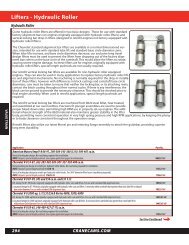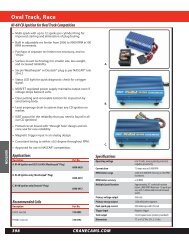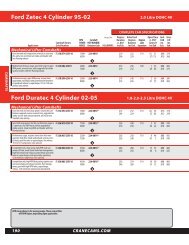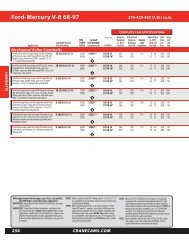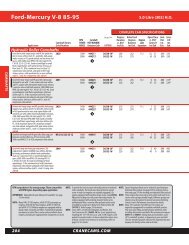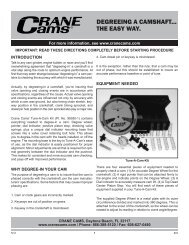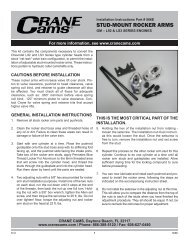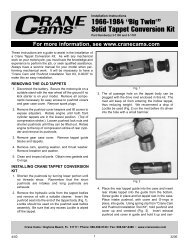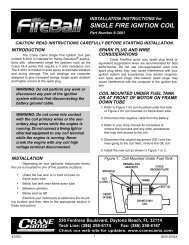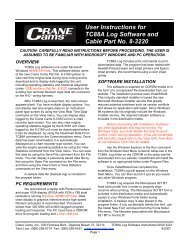2011 - Crane Cams
2011 - Crane Cams
2011 - Crane Cams
You also want an ePaper? Increase the reach of your titles
YUMPU automatically turns print PDFs into web optimized ePapers that Google loves.
VALVE TRAIN<br />
Adjusting the Valve Train<br />
Mechanical Lifters<br />
All pushrod engines using mechanical (solid) lifters, or<br />
mechanical roller lifters, must have an adjustable valve train<br />
so that precise adjustment for “Valve Lash” can be made to<br />
match the camshaft’s requirements. Valve lash is the running<br />
clearance that exists between the tip of the valve stem<br />
and the valves mating surface of the rocker arm. (It is<br />
expressed in the <strong>Crane</strong> Catalog as “Valve Lash” and on the<br />
camshaft specification card as “Valve Setting”. Both terms<br />
mean the same thing.) The amount of valve lash can vary<br />
between camshaft profile designs, being as small as .010” on<br />
some and as great as .035” on others. It is important to use<br />
the recommended valve lash when you first test the performance<br />
of the engine. You must also be concerned with thermal<br />
expansion of the engine components. This is especially<br />
true if using aluminum alloy cylinder heads, or block. For<br />
this reason, <strong>Crane</strong> requires that the valve lash be set with<br />
the engine “Hot” on all pushrod engines using mechanical<br />
lifters. This will insure that the minimum required clearance<br />
(valve lash) is maintained throughout the engine’s operating<br />
temperature range.<br />
Compensating for a Cold Engine when Adjusting Valve<br />
Lash<br />
When installing a new cam, the engine will be cold but the<br />
lash specifications are for a hot engine. What are you to do?<br />
There is a correction factor that can be used to get close. We<br />
mentioned that the alloy of the engine parts can be affected<br />
by thermal expansion in different ways, therefore the<br />
amount of correction factor to the lash setting depends on<br />
whether the cylinder heads and block are made out of cast<br />
iron or aluminum. You can take the “hot” setting given to<br />
you in the catalog or cam specification card and alter it by<br />
the following amount to get a “cold” lash setting.<br />
• With iron block and iron heads, add .002”<br />
• With iron block and aluminum heads, subtract .006”<br />
• With both aluminum block and heads, subtract .012”<br />
Remember this correction adjustment is approximate and is<br />
only meant to get you close for the initial start up of the<br />
engine. After the engine is warmed up to its proper operating<br />
temperature range, you must go back and reset all the<br />
valves to the proper “hot” valve lash settings.<br />
Setting Valve Lash on Mechanical <strong>Cams</strong><br />
All the valves must be set individually and only when the<br />
lifter is properly located on the base circle of the lobe. At<br />
this position the valve is closed and there is no lift taking<br />
place. How will you know when the valve you are adjusting<br />
is in the proper position with the lifter on the base circle of<br />
the cam? This can be accomplished by watching the movement<br />
of the valves.<br />
1. When the engine is hot (at operating temperature)<br />
remove the valve covers and pick the cylinder that you<br />
are going to adjust.<br />
2. Hand turn the engine in its normal direction of rotation<br />
while watching the exhaust valve on that particular cylinder.<br />
When the exhaust valve begins to open, stop and<br />
adjust that cylinder’s intake valve. (Why? Because when<br />
the exhaust is just beginning to open, the intake lifter will<br />
be on the base circle of the lobe, so the intake is the one<br />
we can now adjust.)<br />
376<br />
CRANECAMS.COM<br />
3. Use a feeler gauge, set to the correct valve lash, and place<br />
it between the tip of the valve stem and rocker arm,<br />
unless otherwise specified. Adjust until you arrive at the<br />
proper setting and lock the adjuster in place.<br />
4. After the intake valve has been adjusted, continue to<br />
rotate the engine, watching that same intake valve. The<br />
intake valve will go to full lift and then begin to close.<br />
When the intake is almost closed, stop and adjust the<br />
exhaust valve on that particular cylinder. (Again, when we<br />
see the intake valve almost closed, we are sure that the<br />
exhaust lifter is on the base circle of the lobe.) Use the<br />
feeler gauge and follow the procedure described before<br />
in step 3.<br />
5. Both valves on this cylinder are now adjusted, so move to<br />
your next cylinder and follow the same procedure again.<br />
In the future you may find shortcuts to this method, but it<br />
still remains the best way to do the job correctly.<br />
Using Valve Lash to Help Tune the Engine<br />
The engine only responds to the actual movement of the<br />
valves. Since the valve cannot move until all the running<br />
clearance (valve lash) has been taken up, the amount of<br />
valve lash you use affects the engine’s performance. For<br />
example, if you decrease the amount of (hot) valve lash, the<br />
valve will open slightly sooner, lift higher, and close later.<br />
This makes the camshaft look bigger to the engine, because<br />
of a slight increase of actual running duration and lift. If you<br />
increase the amount of (hot) lash the opposite occurs. The<br />
valve will open later, lift less, and close sooner. This shows<br />
the engine a smaller cam with slightly less actual running<br />
duration and lift. You can use this method on a trial basis to<br />
see what the engine responds to and keep the setting that<br />
works the best. Just remember, the more lash you run, the<br />
noisier the valve train will be. If the clearance is excessive it<br />
can be harsh on the other valve train components.<br />
Therefore, for prolonged running of the engine we do not<br />
recommend increasing the amount of hot lash by more<br />
than +.004” from the recommended setting. Nor do we recommend<br />
decreasing the hot lash by more than -.008”.<br />
Warning:<br />
“Tight Lash” camshafts cannot deviate from the recommended<br />
hot lash setting by more than +.002” increase, or<br />
-.004” decrease. “Tight Lash” cams are those which have recommended<br />
valve settings of only .010”, .012”, or .014” on the<br />
specification card. These lobe designs have very short clearance<br />
ramps and cannot tolerate any increase in the recommended<br />
valve lash. The extra clearance can cause severe<br />
damage to valve train components.<br />
With “Tight Lash” cams, we recommend using only the prescribed<br />
amount of hot valve lash, and that close inspection<br />
of the engine be maintained.<br />
Please realize that changing valve lash settings from the recommended<br />
design specifications will change the harmonic<br />
characteristics of the valve train, possibly causing valve<br />
spring deteriation and breakage.



